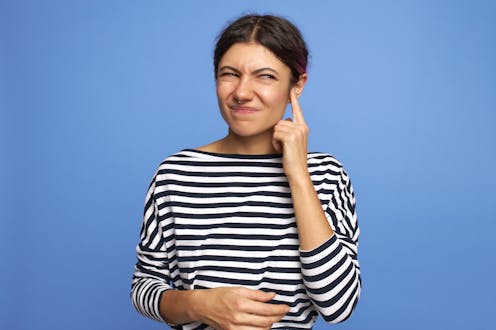
Each year, more than 2 million people in the UK have troublesome earwax that needs to be removed. However, more people are finding that this service is no longer being provided at their GP surgery. In fact, 66% of people seeking these services have been told that earwax removal is no longer available on the NHS.
Questions have been raised in parliament about why people are being referred to earwax clinics in hospitals. This results in long waiting times and is not the best use of specialist services.
Many people are resorting to using private services on the high street that cost around £50 to £100. But the Royal National Institute for Deaf People (RNID), a charity, reports that more than a quarter of people they surveyed cannot afford to pay to have their earwax removed privately. This especially applies to people requiring recurrent earwax removal, such as those who wear hearing aids and earbud earphones – which tend to cause impacted earwax.
Our bodies produce earwax to clean, protect and keep our ears healthy. Movement of the jaw, as well as the skin that lines the ear canal, causes the wax to move to the entrance of the ear where it then flakes off or is carried away when we wash. Sometimes this doesn’t work and the earwax becomes impacted. Impacted earwax that blocks the ear canal is a major reason for GP consultations.
The National Institute for Health and Care Excellence (Nice) is clear that NHS earwax removal services should be provided in the community where demand is greatest. Why is this recommendation for community earwax removal services falling on deaf ears?
A recommendation from Nice is not a mandate, and GPs are under no obligation to offer an earwax removal service. There are several reasons this service is often no longer offered in primary care, some of which are based on misunderstandings.
First, manual water-filled syringes for flushing out earwax can cause high pressure of water and might damage the patient’s ears – not something a GP wants to be responsible for doing. (Alternative cheap, low-pressure water irrigation devices are now widely available.)
Second, there is a mistaken belief among some GPs that earwax can be self-managed using wax-softening ear drops on their own. However, there is no good quality evidence that softened earwax dissolves and magically disappears into the ether.
Effects of impacted earwax
The most common symptom caused by impacted earwax is hearing difficulty. This is often accompanied by discomfort and noises in the ears. Healthwatch Oxfordshire, a charity, revealed that adults with earwax required between one and four NHS visits before attending a dewaxing clinic and that the time from first experiencing symptoms to final resolution was three to 30 weeks.
Try simulating the effect of impacted wax by walking around with your fingers firmly plugging both of your ears for a few days. You’ll soon realise that what at first sounds trivial is no laughing matter.
Hearing difficulty means you can’t communicate with ease or listen to the TV. It also reduces your ability to detect and monitor sounds in the environment, such as an approaching car. Hearing difficulty can lead to social isolation and depression. More than nine out of ten people report that impacted earwax was at least moderately bothersome to them, and 60% said it is very or extremely bothersome.
Nice recommends that impacted earwax is removed by irrigating the ear with the newer, safer low-pressure water irrigation devices, or microsuction to hoover it up. When questioned, most people do not have a preference, although some report that water irrigation is messy and others that microsuction causes discomfort and is noisy.
Removal of earwax in health centres using microsuction results in levels of patient satisfaction that are at least as good as those provided in a hospital.
Before removal, pre-treatment drops or sprays are used to soften the earwax. These are applied daily for up to five days before removal. There is a vast array of pre-treatment earwax softening products, but none are better than any other. As a result, most people use olive oil, which can be administered as drops or as a spray.
There are a variety of self-administered, earwax management products on the market but the evidence for these is limited and none are currently recommended by Nice. An example is the use of Hopi ear candles or cones. To use these, you lie with your head on one side and place the lit candle in the upward-facing ear.
These are reported to work by softening the wax and then sucking it out of the ear canal and up the cone like a chimney. There is no evidence to support this claim. These candles and cones cost money and are ineffective.

How it could be done
If individual GP surgeries lack the expertise or funding to provide earwax removal services, an alternative is for groups of practices to collaborate as a network. The portable nature of modern wax removal equipment is ideal in such settings and for use in home visits. This approach could be especially valuable for vulnerable people, such as those in care homes where 44% of residents with dementia also have impacted earwax.
In the meantime, the withdrawal of NHS earwax removal services is having a far-reaching impact, with people experiencing bothersome and distressing symptoms, sometimes leading to poor mental health.
Kevin Munro does not work for, consult, own shares in or receive funding from any company or organization that would benefit from this article, and has disclosed no relevant affiliations beyond their academic appointment.
This article was originally published on The Conversation. Read the original article.







